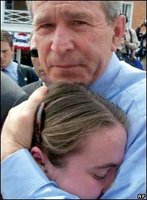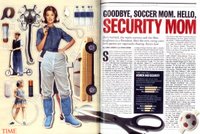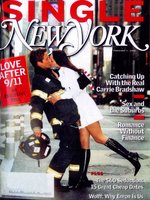Commentary
New essays and articles by Susan Faludi.
The Rescue of Pvt. Jessica Lynch, the Soldier Remade into the ‘Helpless Young Girl,” 2003.
October 29, 2007

It would be more accurate to say that I Am a Soldier, Too belonged to its Boswell, Rick Bragg, a former New York Times correspondent who had recently left the paper under a cloud, after acknowledging that he had outsourced his reporting on an article to an intern who was neither paid nor credited for it. In this case, Bragg had interviewed Lynch, but she seemed strangely absent in the resulting account. The “I” in the title was missing from the text, which was told in the third person. The ghostwriter had ghosted his subject. And imposed on her an interpretation of the hours right after the accident that she didn’t recall, having been out cold. Of these conjured memories, Lynch told Time, “It’s like reading a book that really wasn’t about me.”
The Presidential ‘Hug’ that Became the Most Effective and Expensive Ad of the 2004 Campaign
October 23, 2007
 A few days before Mother’s Day in 2004, President Bush made a brief campaign stop in the Republican stronghold of Lebanon, Ohio. His handlers were hustling him down the crowded rope line outside the Golden Lamb Hotel when a voice cut through the din: “Mr. President! This girl lost her mom in the World Trade Center on 9/11!” Bush, according to the muchburnished retellings, wheeled around and plunged back down the line.
A few days before Mother’s Day in 2004, President Bush made a brief campaign stop in the Republican stronghold of Lebanon, Ohio. His handlers were hustling him down the crowded rope line outside the Golden Lamb Hotel when a voice cut through the din: “Mr. President! This girl lost her mom in the World Trade Center on 9/11!” Bush, according to the muchburnished retellings, wheeled around and plunged back down the line.Linda Prince, the woman who belted out the summons, had arrived many hours earlier to stake out a position up front for her neighbor, Lynn Faulkner, and his fifteenyearold daughter, Ashley, the girl who lost her mom. The president “locked” eyes with the grieving teenager.
“I know that’s hard,” he said. “Are you all right?”
“I’m OK,” she said.
Then he gave her “The Hug.” The moment was captured by Ashley’s father, a marketing consultant and ardent Bush supporter, who had purchased a new digital camera for the occasion. After professedly averting his eyes from the viewfinder to grant his daughter her “private moment” with the president, Lynn Faulkner went home and e-mailed the photograph to more than a dozen “friends and family” across the country. They must have been wellpositioned intimates; by the next day, the photo was on prominent display on the Drudge Report and scores of conservative blogs. The day after that, The Hug ran in the Cincinnati Enquirer and soon thereafter was enjoying national news coverage. As various reverential accounts of this “emotionpacked encounter” later characterized it, the president had “stopped in his tracks” when he heard the call and fought his way “against the flow” of the rope line, and “without fanfare” and “in one of those huge solitary moments that speak legions” had “instinctively reached for the teenager, clutched her head, placed it on his chest—and just held her.”
The photo drew a record 1.6 million page views on the Cincinnati Enquirer’s Web site. In the echo chamber of the conservative blogosphere, the photo was said to reveal Bush as a man of “strength” with “the courage to do what needs to be done to protect our country.” “The protective encirclement of her head by President Bush’s arm and hand is the essence of fatherly compassion,” said a particularly adoring post on FreeRepublic.com. To Bush’s backers, the photo became the money shot. “Nothing speaks better to the compassion, the character, and the leadership of the president,” Brian McCabe, the head of one of the biggest Republican funding groups, told CNNfn. Some weeks after Lynn Faulkner snapped that single frame, McCabe’s group, the Progress for America Voters Fund, dispatched a camera crew to the Faulkners’ home to film “Ashley’s Story,” a multimillion-dollar political commercial.
The Presidential Candidates Compete for the Title of Crockett-in-Chief.
October 16, 2007

Sen. John Kerry on the campaign trail, 2004.
In the post-9/11 effort to restore Americans’ confidence in the country’s impregnability, national politics would become increasingly deranged. The demonstrations, as often as not, were comically absurd, as witness the deskbound officeholders of the 2004 presidential campaign out in the woods, felling flora and blasting fauna to prove their virile bona fides. But the needs these staged exertions in the wild addressed ran deep in the American past, far deeper than the superhero fantasies we constructed around our leaders. The attack on home soil triggered a search for a guardian of the homestead, a manly man, to be sure, but one particularly suited to protecting and providing for the isolated American family in perilous situations. He was less Batman than Daniel Boone, a frontiersman whose proofs of eligibility were the hatchet and the gun—and a bloody willingness to wield them.
As soon as hunting season opened, a camo-coveralled Kerry could be found in one frostladen duck blind after another. Blearyeyed journalists rose before dawn to follow him. There was the pheasant hunt in Iowa (where Kerry inspected the neck of his fresh kill before a phalanx of photographers), the goose hunt in Ohio (where Kerry emerged from a cornfield with a hand “stained with goose blood” but empty of an actual carcass), and another clay pigeon hunt in Wisconsin (no blood, but the candidate reportedly plugged seventeen of his twentyfive marks). At a campaign appearance in West Virginia, Kerry hoisted a shotgun onstage and told an audience of miners that he’d like to go “gobblehuntin’.” In Pike County, Ohio, Kerry dropped in on the Buchanan Village Gun Shop to inquire, in freshly acquired twang, “Can I get me a hunting license here?” It was a moment that inspired a National Review columnist to invoke the sodomy scene in Deliverance: “What will Kerry say if he goes on the campaign trail into deepest Appalachia? ‘Squeal like a pig?’”
The Manly Supersizing Of Political Leaders After 9/11, National Review Cover, 2001
October 12, 2007
 America will need more “heroes,” Defense Secretary Donald Rumsfeld told the Armed Forces one day after 9/11, and however reliable his intelligence on matters of actual defense, on this point he proved prescient. The press, for its part, heeded Rumsfeld’s pronouncement by nominating him to the role, in the process dressing him up in some curious costumes. National Review’s December 31, 2001, cover story featured a drawing of Rumsfeld in Betty Grable pose, beside the headline “The Stud: Don Rumsfeld, America’s New PinUp.” “Reports have it that people gather round to watch Rumsfeld press conferences the way they do Oprah,” the story claimed. “Women confide that they have . . . well, undefense-policylike thoughts about the secretary of defense.” Fox called Rumsfeld a “babe magnet,” and People named him one of the “sexiest men alive.” Conservative doyenne Midge Decter penned a booklength valentine, Rumsfeld: A Personal Portrait, which included beefcake shots of the young “Rumstud” as a bicepbulging wrestler and a socialite’s breathy confession that she kept his photo tacked to her dressingroom wall. “He works standing up at a tall writing table,” Decter wrote, “as if energy, or perhaps determination, might begin to leak away from too much sitting down.” His secret, she said, was “manliness.”
America will need more “heroes,” Defense Secretary Donald Rumsfeld told the Armed Forces one day after 9/11, and however reliable his intelligence on matters of actual defense, on this point he proved prescient. The press, for its part, heeded Rumsfeld’s pronouncement by nominating him to the role, in the process dressing him up in some curious costumes. National Review’s December 31, 2001, cover story featured a drawing of Rumsfeld in Betty Grable pose, beside the headline “The Stud: Don Rumsfeld, America’s New PinUp.” “Reports have it that people gather round to watch Rumsfeld press conferences the way they do Oprah,” the story claimed. “Women confide that they have . . . well, undefense-policylike thoughts about the secretary of defense.” Fox called Rumsfeld a “babe magnet,” and People named him one of the “sexiest men alive.” Conservative doyenne Midge Decter penned a booklength valentine, Rumsfeld: A Personal Portrait, which included beefcake shots of the young “Rumstud” as a bicepbulging wrestler and a socialite’s breathy confession that she kept his photo tacked to her dressingroom wall. “He works standing up at a tall writing table,” Decter wrote, “as if energy, or perhaps determination, might begin to leak away from too much sitting down.” His secret, she said, was “manliness.”However odd the idolatry, Rumsfeld wasn’t alone in receiving the award for best actor in an unconvincing role. His boss also got the treatment. Passing tactfully over the president’s initial missinginaction performance after 9/11, Newsweek assured readers that George Bush was exercising heroic control: “Behind the scenes, aides say, Bush never exhibited anything but serenity, focus and determination,” and he was presiding over warroom sessions with “a commander’s grip.” In the Weekly Standard, Fred Barnes declared Bush “a man with a mission,” driven by “a calling like that of a fireman who feels called to his work to save people.” Barnes’s evidence: “He could have taken a less dangerous, better paying job, but he didn’t.” David Brooks marveled at Bush’s “strenuous tone” and likened his speaking style to Teddy Roosevelt’s.
The Mythical “Security Mom”
October 9, 2007

Pollster David Winston of the GOPaffiliated research firm the Winston Group, asserted that “most Americans see the 9/11 attacks as a defining moment in their lives—and no one group was more affected than women, especially married women with children.” In an October 2004 column in the New York Post titled, a tad defensively, “Security Moms Are Real,” Winston described the emergence of this new female perspective:
My first inkling that 9/11 would have more than just a passing impact on women came only a month after the attacks. As Congress considered legislation to allow the arming of pilots, I did a survey for the Allied Pilots Association and United Seniors Association. One finding surprised a lot of people: Married women with children were the biggest proponents of putting guns in the cockpit—favoring the idea by a whopping 78 percent, five points higher than men.
To go from a narrowly defined question about cockpit security to a grand statement about the impact of 9/11 on women was something of a leap, and Winston offered only one other study to justify it: a 2004 poll conducted by his group just a few weeks after the Beslan school massacre that found that 26 percent of married women with children cited “defense/terror” as their top concern, narrowly beating out “economy/jobs,” at 24 percent. (He did not offer comparable figures for men.) Nonetheless, pollsters on both sides of the party divide were ready to jump. The presidential candidates were playing the part of guntoting sentinels to speak to the security mom’s fears as much as to her husband’s fury, as electoral analysts informed the press. “It’s about getting men’s votes, but this year it’s also about getting women’s votes,” Democratic pollster Celinda Lake told USA Today in the fall of 2004. “What in the past seemed too arrogant, too macho, women really like this cycle. They want someone who will do what it takes to protect America.”25
The Bush campaign’s “W Stands for Women” initiative was based on that premise. Frontloaded with female volunteers and merchandised with pink baseball caps for sale on the WStandsforWomen Web site, the effort launched in May 2004—timed to coincide, of course, with Mother’s Day. Mindy Tucker Fletcher, cochair of the W Stands for Women national steering committee, told the press that for the security mom the election would come down to one question: who would she want to protect her “if September 11 happened again?” To answer that question, the W promoters offered up two such mothers who were all in the family—literally. “You know, I’m a security mom,” Vice President Dick Cheney’s daughter Elizabeth told CNN. “I’ve got four little kids. And what I care about in this election cycle is electing a guy who is going to be a commander in chief, who will do whatever it takes to keep those kids safe.” The second was Laura Bush, who quickly attained status as the Mother of All Security Moms. On the afternoon talk shows, in ads on the Web sites of women’s magazines like Ladies’ Home Journal and Family Circle, and, ultimately, from the dais of the Republican National Convention, she assured American mothers of “George’s work to protect our country and defeat terror so that all children can grow up in a more peaceful world.”26*
The ‘Trend’ of Women Lusting after Firemen
October 3, 2007

The idea that hordes of women were drooling over the men in boots was promoted by the purveyors of firefighter calendars (sales of the “2002 Hotlanta Firemen” are “going through the roof,” its merchandiser claimed), matchmakers eager to expand their date pool (“They certainly have a lot more glamour and a lot more of that hero mystique,” the proprietor of Misty River Introductions said), and impresarios at celebrity benefits (Denis Leary, the creator and star of the TV firefighter drama Rescue Me, auctioned off two dates with firemen at a Manhattan fund-raiser with this come-on to grown women: “If you’re a girl, kiss a fireman!”). The promulgators of the lustforfiremen trend were hardly feminists, but their declarations were seized upon as evidence that women were shedding their feminist principles. “In three decades, feminism has done a backflip,” New York Times columnist Maureen Dowd wrote. “Once men in uniform were the oppressors. Now they’re trophy mates. Once cops were pigs. Now they’re foxes.”
Few of the stories offered an actual woman in a romantic relationship with an actual fireman. Or even a onenight stand. On CBS, the Early Show’s Lisa Birnbach quizzed Mara Brandon, a massage therapist who had volunteered her services at the local fire station:
BIRNBACH: The firemen are cute. I would—I would massage one.
BRANDON: Oh, yeah. Oh, definitely.
BIRNBACH: Did you do any single firemen?
BRANDON: No. No.
At the Orange County Register, reporter Emily Bittner got around the noexamples problem by paying a fireman to take her on a date. (The newspaper picked up the tab.) After a detour to the nail salon (“When my pedicurist asked what color to paint my toenails, I knew to answer, Fireengine red”), she hurried over to the Santa Ana fire station armed with “a wad of $20s” to meet “my Real Man.” Firefighter Jorge Vargas, whom she described as “5-foot-9, weighs 185 and is pure muscle,” took Bittner out “in his 2001 Ford Ranger—fire-engine red.” If his habits weren’t as macho as she had envisioned—her first sight of him was “washing breakfast dishes” and his restaurant choice was a sushi bar—she assured her readers he fulfilled all the requirements of a dream date. “All day I’d wondered whether the Real Man could kiss. All I can say is wow, can he ever.”
Previous Posts
- This blog has moved
- Articles by Susan Faludi
- The Rescue of Pvt. Jessica Lynch, the Soldier Rema...
- The Presidential ‘Hug’ that Became the Most Effect...
- The Presidential Candidates Compete for the Title ...
- The Manly Supersizing Of Political Leaders After 9...
- The Mythical “Security Mom”
- The ‘Trend’ of Women Lusting after Firemen
- America's Guardian Myths
- The Heroics of Futility